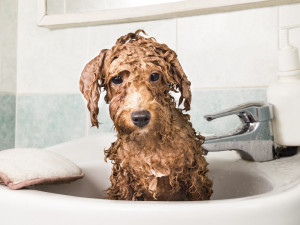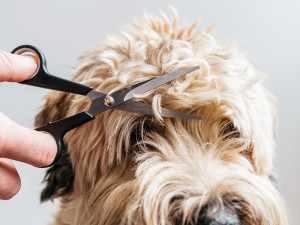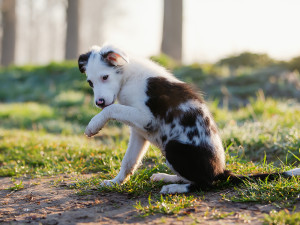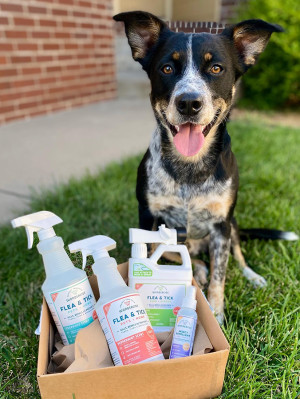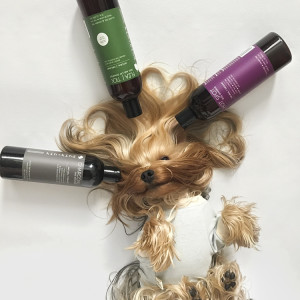Home Remedies For Getting Rid of Fleas on Dogs — Naturally
How to stop your home from becoming a flea circus.
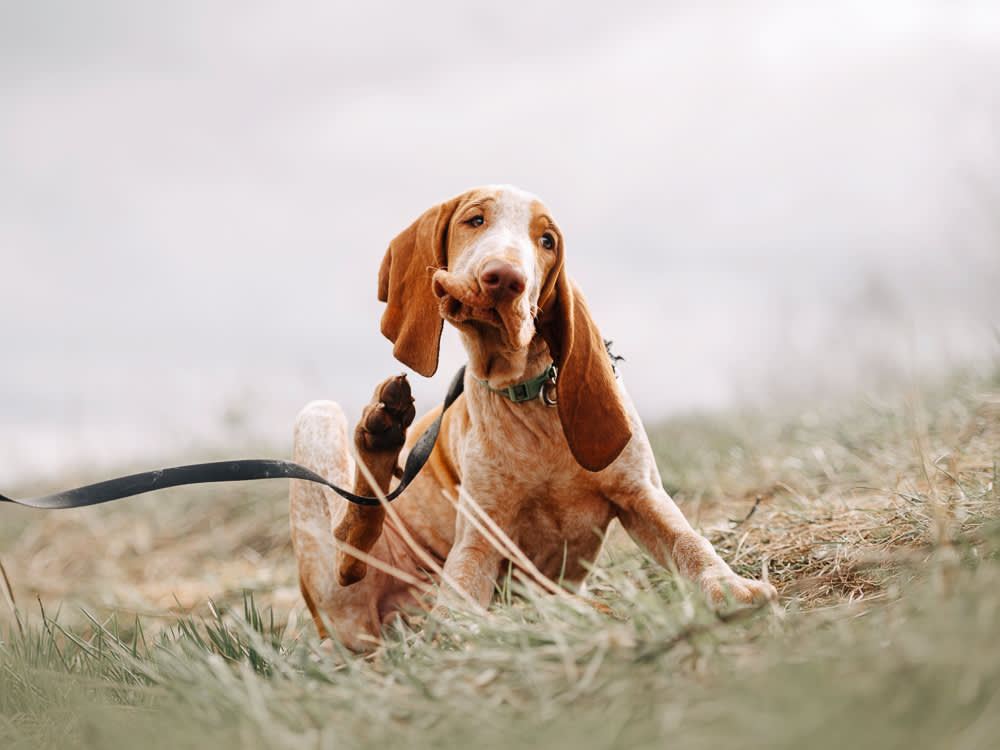
share article

Your pet wants you to read our newsletter. (Then give them a treat.)
Ugh, fleas. Why? Fleas are a nuisance, both to your dog and to your household. To combat them, you have a choice between commercial chemical products and natural remedies. If you’re dealing with a flea infestation, you should probably turn to the hard stuff. But if you want to prevent fleas from hitching a ride on your pet in the first place, here are some benefits of natural flea treatments for dogs — many of which you can mix up from ingredients you probably already have in your kitchen.
What’s the Deal with Fleas?
Regardless of what breed they are or where they live, many dogs are afflicted by fleas. These tiny pests, whose bites provoke an itching sensation, irritate dogs no end, resulting in what seems like nonstop scratching. Scratching is just the tip of the proverbial iceberg, though. Dogs who are allergicopens in a new tab to flea saliva can develop skin redness, welts and swelling, not to mention skin lesions opens in a new tabfrom constant licking. Flea bites can also cause anemia, and — if fleas are ingested during the dog’s non-stop grooming — tapeworm infestations.
Then there’s the housework. A dog’s constant scratching spreads loose hair and dead skin. Adding to the challenge, fleas lay eggsopens in a new tab in inaccessible and difficult-to-clean areas of your home, including along baseboards, under furniture, and in cracks in floorboards. Clearly, you need to fight back, both for your pup’s sanity and your own. Here are some home remedies to get rid of those pesky fleas.
How to Get Rid of Fleas on Dogs
Depending on where you live, fleas may be a seasonal or a year-round problem. “We try to avoid using toxins in and on our pets (and in our own environments), but in some cases, we may need to choose our battles based on how difficult the flea/tick problem is to tackle,” Dr. Katie Kangas says.
Generally, they’re the biggest menace during the summer, when dogs spend more time outside. “Fortunately, in many geographical regions, the use of pharmaceutical flea and tick products can be avoided through much of the year and minimized to only a few times of use during the summer season,” Dr. Kangas says. “To best support our pets’ health and wellbeing, there are natural, non-toxic options for flea and tick prevention.”
Fleas themselves are very tiny and move quickly, so a simple visual inspection isn’t always enough. To find out if your dog has fleas, check for black specks on their coat and skin. These are flea droppings (gross!). Or, check for specks by rubbing a white tissue across your dog’s fur. Here are some natural home remedies if your sleuthing turns up evidence of fleas.
Btw, our editors (and their pets) picked out these products. They’re always in stock at the time we publish, but there’s a chance they’ll sell out. If you do buy through our links, we may earn a commission. (We’ve got a lot of toys to buy over here, you know?)
1. Flea comb
An affordable and practical solution, a flea comb is a must-have for pet parents looking for a natural flea-killer. They come in various sizes, but all have closely spaced teeth that remove both eggs and fleas from the dog’s coat. (Be sure to dip the comb in soapy water after each pass to kill the eggs and adults the comb picks up.) This is a great first step in your war on these pests.
2. Sprays
Apple cider vinegar’s slightly acidic pH level creates an inhospitable environment for fleas. Mix six cups of ACV with four cups of water (use a 6:4 ratio), add a pinch of salt, and spray the mixture on your dog’s coat and underbelly, making sure to avoid their eyes and any wounds they may have.
Kin + kind Maximum Flea & Tick Protection Setopens in a new tab
Wondercide Flea, Tick & Mosquito Spray for Dogsopens in a new tab
3. Baths
Dip your dog’s comb in fresh lime or lemon juice and make multiple passes through their coat. (If your dog has a short or slick coat, you can also use a cloth dipped in the juice instead of a comb.) Another option is to dilute lemon juice with water (use a 1:2 ratio) and add a splash of pet shampoo.
4. Flea Collars
Dilute two to three drops of oil in one to three tablespoons of water and apply a few drops to your pet’s existing collar or to a bandana. (You’ll need to reapply this mixture regularly. See Barbara Fougère’s book, The Pet Lover’s Guide to Natural Healing for Dogs and Cats, for more detailed instructions.) Lavender or cedar oil naturally repels fleas, but be sure to test them with your dog before using them on anything that goes around their neck. “Some essential oils have flea and tick-repellent qualities (such as cedar) — other essential oils are toxic to petsopens in a new tab,” Dr. Kangas says. It’s important to talk to your vet.
How to Get Rid of Fleas in Your Home and Yard
A flea’s life cycle — from egg to adult — is roughly two to three weeks, so weekly cleaning goes a long way toward preventing fleas from settling in. “Natural options for flea and tick repellents in their environment are also an effective preventive measure,” Dr. Kangas says. “Keep in mind that fleas live more in the environment than on the pet, so if you are finding them on your pet, you will want to address your home environment as well.”
One of the first things to do when you notice a flea infestation is to launder (if possible, using hot water) all machine-washable soft furnishings your dog comes in contact with, including sofa and pillow covers, blankets, cushion covers and curtains, then tumble dry for about 20 minutes on high (or a little longer on lower heat if the material is subject to shrinkage). This will kill both adult fleas and larvae. Even when you don’t see fleas, it’s a good idea to regularly launder anything your dog sleeps on, and to vacuum floors and furniture at least weekly; a monthly steam-cleaning can also help.
More than 90 percent of the flea population in the home environment is in the form of eggs, larvae, and pupae. Flea larvae don’t like light, so be sure to vacuum under furniture and around baseboards, too.
5. Diatomaceous earth
Diatomaceous earthopens in a new tab is basically the fossilized remains of microscopic diatoms, broken down into a fine, white, silica-based powder. When fleas and other pests (ticks, ants, bedbugs) come into contact with it, it destroys their exoskeletons and they dry out and die. Diatomaceous earth comes in two forms, pool/filter- and food-grade; be sure to get the food-grade, which is low in crystalline silica and nontoxic to humans and animals. You should, however, wear a mask when distributing it, as it can irritate eyes and throat.
Sprinkle it in areas where you suspect high flea activity. “It can be sprinkled on your pet’s bedding, as well as carpets, furniture, and anywhere else your pet spends a lot of time. Leave the diatomaceous earth dust down for about 24-48 hours and then vacuum the area thoroughly,” Dr. Kangas says. Empty the vacuum canister or replace the bag outside. It can also be used outside on the lawn or on any area in which your dog regularly stretches out.
6. Baking soda and salt
Much like diatomaceous earth, baking soda and salt dehydrate fleas and their eggs. Liberally sprinkle the mixture around your house and use a broom to work it into carpet fibers or under furniture. Leave for a day or two and vacuum thoroughly. Clean your vacuum carefully afterward (salt can cause rust) and, as with diatomaceous earth, empty the canister or replace the bag outside.
7. Nematodes
Small worms that eat insect larvae, nematodes live in the soil, and some types can be very helpful in the fight against termites, grubs, and fleas. Order them online and mix the nematodes with water, then spray throughout your yard. “Nematodes are used to protect gardens and plants from ants and caterpillars but also provide effective prevention for fleas and ticks, as they feed on these insect’s larvae stages while they are still in the soil,” Dr. Kangas says. Read the packaging carefully; it’s very important to use the correct amount of water.
8. Rosemary
Steep the rosemary needles in boiling water, strain and dilute. When the water reaches a comfortable temperature, pour it over your dog and work into their coat. Using a pestle and mortar, you can also make a fine powder with dried rosemary, fennel, wormwood, and rue to sprinkle around your home. Make sure your dog is comfortable with the smell before using it as a dip or an ingredient in the sprinkling powder.
Finally, many sources recommend giving dogs brewer’s yeastopens in a new tab to help repel fleas; while the science behind this is slight, anecdotally, it seems to help, although it takes time to start working. (Check with your vet before trying this). Above all, feed your dog a balanced diet and be vigilant about their health. Fleas are less successful in setting up shop on healthy, well-fed dogs.
9. Essential Oils
While some essential oils have been rumored to keep fleas away, they need to be used with the utmost caution, as many are toxic to dogsopens in a new tab (and downright deadly to catsopens in a new tab). It’s best to consult with your vet before adopting this approach. Essential oils must be diluted in a carrier oil before being sprayed on, applied to your dog’s coat, or added to your dog’s shampoo. “I recommend Wondercide for indoor and outdoor flea protection,” Dr. Kangas says. But if there are also cats in your home, steer clear of essential oils entirely — that includes essential oil diffusers.
Essential oils toxic to dogs: Tea tree oil, pennyroyal, oil of wintergreen, and pine oils.
Essential oils toxic to cats: Tea tree oil, pennyroyal, oil of wintergreen, pine oils, oil of sweet birch, citrus oil (D-limonene), ylang ylang oil, peppermint oil, cinnamon oil, clove oil, and eucalyptus oil.
FAQs (People Also Ask):
What kills fleas on dogs naturally?
Kill fleas naturally with diatomaceous earth, apple cider vinegar, and lemon juice treatments. Frequent laundry and vacuuming are a must to keep your home clear of fleas.
How do I make homemade flea treatment for my dog?
Make a homemade flea treatment by mixing six cups apple cider vinegar, four cups water, and a pinch of salt. Spray DIY treatment on the dog’s coat — avoid eyes and wounds.
Does Dawn dish soap kill fleas on dogs?
Yes, Dawn dish soap effectively kills fleas and their eggs on dogs. Dip your flea comb into a bowl of soapy water with each pass to ensure the fleas are killed.
What is the best homemade flea killer?
The best homemade flea killer is a simple apple cider vinegar and water mixture (6:4 ratio). Spray the liquid on the dog’s fur. Avoid their ears, nose, eyes, and mouth.
References
Sue Faust
Sue Faust is the owner of Paws Playgrounds, a dog daycare and dog-boarding service provider in downtown Toronto. She has spent years researching refining best practices in dog care services.
Related articles
![Fluffy brown and white puppy dog scratching a lot with its paw]() opens in a new tab
opens in a new tabYour Itchy Dog Deserves Relief — Here’s What to Do
How you can help them feel better fast.
![Mixed-breed puppy licks its paw in the grass]() opens in a new tab
opens in a new tabHot Spots on Dogs: Causes, Symptoms, and Treatment
Unfortunately, this term refers to a “summer sore,” not a club coveted by SNL’s Stefon.
![a pug is cradled by a person in scrubs with a stethoscope]() opens in a new tab
opens in a new tabEverything You Need to Know About Heartworm
Heartworm disease is as gnarly as it sounds. Here’s how to prevent a horror story from coming true for your pet.
![Dog sitting behind a basket of Wondercide products on the grass outside]() opens in a new tab
opens in a new tabMosquitos Aren’t Going Away — Neither Are Bug Sprays That Are Toxic to Dogs
Enter: Wondercide, a plant-based, sustainable, pesticide-free mosquito-repellent set safe to use around your pet.
![A dog with silky hair posing with dog friendly bathing products.]() opens in a new tab
opens in a new tabKin+Kind’s Pet Care Philosophy is Squeaky Clean
Co-founder Thomas Ling on his passion project-turned-side hustle-turned career.
![Woman holding a beagle in warm dappled summer light]() opens in a new tab
opens in a new tabYou’ve Got a Summer-Lovin’ Pup. Here’s How to Keep Them Safe
Some like it hot (but not most dogs). Here are the season’s health hazards, from fleas to foxtails.
![Dog surrounded by foxtails wearing an OutFox Mask]() opens in a new tab
opens in a new tabFoxtails are Foiled in Dogs with Clever Outfox Field Guard
This unique head gear is designed to help protect dogs’ eyes, ears, and noses from foxtail penetration.



